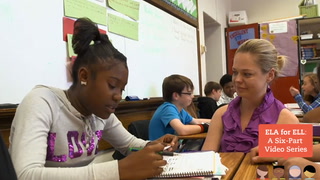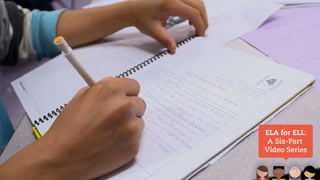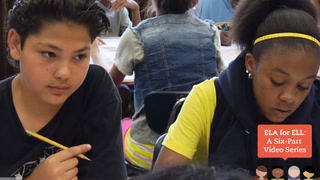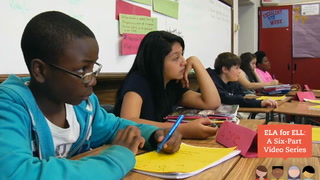Series ELA for ELL: Scaffolding Understanding for Complex Text: Interacting with Complex Texts: Scaffolding Reading
ELA.RI.7.2
| Common core State Standards
- ELA: English Language Arts
- RI: Reading Standards for Informational Text 6-12
- 7: 7th Grade
-
2:
Determine two or more central ideas in a text
and analyze their development over the course
of the text; provide an objective summary of the
text.
ELA.RI.7.4
| Common core State Standards
- ELA: English Language Arts
- RI: Reading Standards for Informational Text 6-12
- 7: 7th Grade
-
4:
Determine the meaning of words and phrases
as they are used in a text, including figurative,
connotative, and technical meanings; analyze the
impact of a specific word choice on meaning and
tone.
ELA.RI.8.2
Common core State Standards
- ELA: English Language Arts
- RI: Reading Standards for Informational Text 6-\x80\x9312
- 8: 8th Grade
-
2:
Determine a central idea of a text and analyze its
development over the course of the text, including its
relationship to supporting ideas; provide an objective
summary of the text.
Save to My Resources
PLEASE CREATE A NEW ACCOUNT OR LOG IN TO ACCESS THIS CONTENT
Enjoy your first video for free. Subscribe for unlimited access.
Have questions about subscribing?
Click Here to learn more about individual subscriptions.
Click Here to learn more about School and Institution access.
Discussion and Supporting Materials
Thought starters
- Ms. Park-Friend frames the reading by using focus questions. Why is this important for ELLs?
- Students are interacting with the text in a variety of ways. How do all of these interactions support students to write their own persuasive speeches?
In Partnership With:

School Details
Bruce Randolph School3955 Steele Street
Denver CO 80205
Population: 760
Data Provided By:

Teachers
Emily Park-Friend
Newest
|
4 MIN
|
5 MIN
|
5 MIN
UNCUT CLASSROOMS
| TCHERS' VOICE
English Language Arts















24 Comments
Kassandra Amaya Oct 15, 2023 2:21pm
A) Using focus questions is important for ELLs because it gives them something to look for while reading. Many people who struggle to understand a reading are ELLs. With these questions, it gives the students something to do and make it seem that the task at hand is manageable instead of impossible.
B) All these interactions help support students with their persuasive writing because they go about discussing the text with not only their teacher but with their peers and while discussing, they gather information and the skills that can help in their writing. Its also a fact that not one strategy works for all students and that trying vaious methods can help students find one that actually works for them.
Elke McReynolds May 22, 2022 10:21pm
Rearanging text back together help kids learn the content in a fun, constructive way. It will also help retain the information for a longer period of time.
Aidanelly Ortiz Feb 9, 2020 9:31am
Focus questions are essential to help students to read having a point to look for while they are reading. It help students become experts on his/her question and be able to share and talk with his/her peers with confidence. Students used different strategies to comprehend this speech about Barbara. They read small parts with a focus questions in mind, they share out their answers, they heard the speech when the teacher read it aloud, they discuss it orally again using guiding questions, they discussed words or concepts difficult to understand, and they built the speech in the jig-saw activity. By using all of those strategies, students will construct their knowledge and will learn all the steps that are necessary to follow in order to create a speech with powerful and cohesive ideas.
Carol Scott Feb 5, 2020 10:05pm
Focused questions are great. These help students to focus on specific aspect of their reading. It forces them to think through and evaluate what they read. This strategy can be used at any level.
Elnora Scott Feb 2, 2020 5:12pm
I see the advantage of providing a focus question for students work with. That question being the focus gives students a target and and other info allows them to develop information aroud the question.